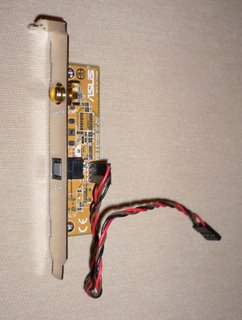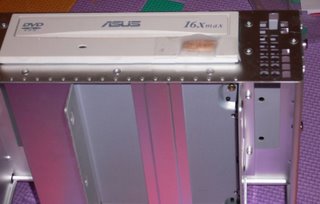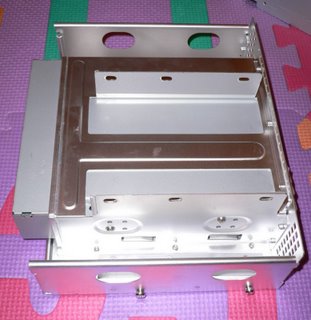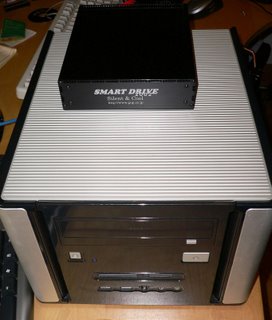A8NVM-CSM Aria Update
MULTIMEDIA BRACKETS


Finally received the SPDIF audio and video connector brackets for my Asus A8NVM-CSM motherboard. It's a real mystery why Asus didn't bother including these brackets with their "multimedia" motherboard, as without these the digital audio and video out functions of this motherboard become unusable. The local Asus dealer does not carry these accessories either, go figure. Fortunately I had some friends travelling to Taiwan and was able to pick these up. Yes having friends travelling to many countries is always helpful to source hard-to-find PC components, especially uncommon silencing parts, but I believe most people have trouble understanding the silent PC enthusisat. Everytime someone helps bring back a component they ask "What is this for? You mean it makes your computer run more quietly?!?" and they have this funny look of disbelief as if you might be pulling their leg.
BIOS UPDATE = LOWER TEMPS
Well I originally purchased my Asus A8NVM-CSM with the Aria as a replacement for my dated HTPC, and now with these brackets I could finally get started. I took out the 7800GT high-end graphics card as I wouldn't be playing any games on my HTPC. Now with only one 92mm CPU fan and one 120mm case fan (both running at lowered speeds with Speedfan), the system was pretty quiet and perfectly suitable for HTPC use. Regarding CPU temperatures, thanks to Steerpike and Ersa's post I discovered that the older BIOS for this board was reporting a significantly higher CPU temperature. I updated my motherboard BIOS from version 0601 to 0702 and discovered this was indeed the case. The CPU and "NB?" readings immediately dropped 8C under the exact same conditions. I compared this both at idle and under load with the same results. The MB temperature was unchanged. Although these readings are only approximate temperatures to begin with, the fact Asus adjusted this in their newer BIOS leads me to believe the newer readings should be more accurate. In the back of my mind I was always wondering why my Opteron was idling so hot even when undervolted to 0.8v 1Ghz.
A NEW DVD BURNER
 I recently picked up a LG GSA-H10N DVD burner for under $40. Prices of DVD burners have come down significantly, I guess in anticipation of Blu-ray and HD-DVD. It's a fast 16x DVD burner (10x DL+R, 8X RW+R) and also has the ability to write DVD-RAM at 12x. Originally I thought of putting this in my main rig to backup data, as my thinking is DVD-RAM format will be more reliable for data. However this optical drive is perfect for the Aria, and much better than the ASUS DVD-ROM I had previously installed.
I recently picked up a LG GSA-H10N DVD burner for under $40. Prices of DVD burners have come down significantly, I guess in anticipation of Blu-ray and HD-DVD. It's a fast 16x DVD burner (10x DL+R, 8X RW+R) and also has the ability to write DVD-RAM at 12x. Originally I thought of putting this in my main rig to backup data, as my thinking is DVD-RAM format will be more reliable for data. However this optical drive is perfect for the Aria, and much better than the ASUS DVD-ROM I had previously installed. In addition to being shorter in length (allowing more space in the tight SFF case), the eject button matches the Aria's front panel button perfectly (for the Asus I had to tape on some extra padding to get good contact). The eject mechanism is also much more polite than the Asus, there is a very short pause after eject is pushed before the tray comes out smoothly, unlike the Asus tray which will shoot out immediately and roughly at high-speed; I am always startled by this and have to make sure I get my hand out of the way quickly. The LG also works nicely with Nero Drive Speed which allows the spin speed to be slowed down (ie made quiet) when playing back DVDs and CDs.
In addition to being shorter in length (allowing more space in the tight SFF case), the eject button matches the Aria's front panel button perfectly (for the Asus I had to tape on some extra padding to get good contact). The eject mechanism is also much more polite than the Asus, there is a very short pause after eject is pushed before the tray comes out smoothly, unlike the Asus tray which will shoot out immediately and roughly at high-speed; I am always startled by this and have to make sure I get my hand out of the way quickly. The LG also works nicely with Nero Drive Speed which allows the spin speed to be slowed down (ie made quiet) when playing back DVDs and CDs.MORE PHOTOS OF THE CPU COOLER
 No further changes were made here, just a few close-up shots of the Thermaltake Silent Pipe CPU heatsink and Silverstone 92mm fan attached with twist-ties.
No further changes were made here, just a few close-up shots of the Thermaltake Silent Pipe CPU heatsink and Silverstone 92mm fan attached with twist-ties. Here you can see the fan is actually elevated from the heatsink by a tiny white foam washer (taken from a pack of CDRs).
Here you can see the fan is actually elevated from the heatsink by a tiny white foam washer (taken from a pack of CDRs).HARD DRIVE SEEK NOISE
The fan noise level is quite acceptable as a HTPC, however the hard drive seek noise is very loud. I am using a Hitachi T7K250 250GB 7200rpm/8MB cache, two-platter SATA2 HDD. A notebook drive would probably make a better choice, but I was hoping the Aria case would allow me to take advantage of larger capacity of a regular 3.5" drive. There should be just enough room to suspend the HDD which should reduce the seek noise, also turning on AAM (Automatic Acoustic Management) should help with some minor trade-off in performance. However why not give my recently acquired SmartDrive 2002C enclosure a try.
 The drive cage of the Aria has three places for mounting a 3.5" HDD. The main spot is oriented horizontally, directly under the optical drive. The second and third are mounted vertically at the sides of the of optical drive. The side mounts are too narrow to fit the Smartdrive 5.25" enclosure, however it could potentially fit in the mount under the optical drive. One side of the cage's two mounting plate needs to be moved, but that can be easily bent down and out of the way.
The drive cage of the Aria has three places for mounting a 3.5" HDD. The main spot is oriented horizontally, directly under the optical drive. The second and third are mounted vertically at the sides of the of optical drive. The side mounts are too narrow to fit the Smartdrive 5.25" enclosure, however it could potentially fit in the mount under the optical drive. One side of the cage's two mounting plate needs to be moved, but that can be easily bent down and out of the way. Unfortunately, the vertical clearance is not enough to fit the Smartdrive unless the CPU fan is removed. Bluefront known at SPCR for his extensive and elaborate silent PC modding actually had a similar idea of using a PW200M inside an Aria case which he details in this post. He works off positive airflow (using the rear 12omm fan to draw in air instead of exhaust) and ducts the air to a fanless XP120 CPU heatsink. His duct idea is very nice, and even manages to mount a notebook hard drive a copper plates as part of the duct wall. I originally thought of using my XP120 heatsink as well, unfortunately the CPU socket on the A8NVM-CSM is too close to the edge and would not fit such a wide heatsink. With some clever ducting, it might still be possible to run a fanless CPU heatsink, but I think I will give such a project a miss for now as the Smartdrive enclosure was intended for my larger main rig.
Unfortunately, the vertical clearance is not enough to fit the Smartdrive unless the CPU fan is removed. Bluefront known at SPCR for his extensive and elaborate silent PC modding actually had a similar idea of using a PW200M inside an Aria case which he details in this post. He works off positive airflow (using the rear 12omm fan to draw in air instead of exhaust) and ducts the air to a fanless XP120 CPU heatsink. His duct idea is very nice, and even manages to mount a notebook hard drive a copper plates as part of the duct wall. I originally thought of using my XP120 heatsink as well, unfortunately the CPU socket on the A8NVM-CSM is too close to the edge and would not fit such a wide heatsink. With some clever ducting, it might still be possible to run a fanless CPU heatsink, but I think I will give such a project a miss for now as the Smartdrive enclosure was intended for my larger main rig.AN INITIAL TEST OF THE SMARTDRIVE
But let's see how well the Smartdrive performs in anycase. As it will not fit inside the Aria case, I will have to test it outside.
 After removing the bottom plate of the enclosure, the HDD slides in between two copper plates that run along the sides of the enclosure. The foam padding pushes against these plates so that it is a very tight fit for the HDD; I used a piece of cardboard to help wedge/slide in the HDD (seen in the photo here). The SATA and power connectors were easily attached and run out the rubber lined back opening.
After removing the bottom plate of the enclosure, the HDD slides in between two copper plates that run along the sides of the enclosure. The foam padding pushes against these plates so that it is a very tight fit for the HDD; I used a piece of cardboard to help wedge/slide in the HDD (seen in the photo here). The SATA and power connectors were easily attached and run out the rubber lined back opening. Oops, I forgot I was using the PW200M which doesn't have a SATA power cable, and I did not want to add a molex-to-sata power adaptor to keep cable mess to a minimum. Hitachi HDD conveniently come with both SATA power as well as molex power connectors allowing the drive to be powered by either connector. Fortunately removing and reinstalling the bottom plate and it's six screws was no big deal.
Oops, I forgot I was using the PW200M which doesn't have a SATA power cable, and I did not want to add a molex-to-sata power adaptor to keep cable mess to a minimum. Hitachi HDD conveniently come with both SATA power as well as molex power connectors allowing the drive to be powered by either connector. Fortunately removing and reinstalling the bottom plate and it's six screws was no big deal. Oops again. How silly; for those observant readers you'll notice I disconnected the SATA data connector instead of the SATA power connector! When the large plug didn't match up to the SATA cable from the motherboard I actually had to pause and think why... it's getting late.
Oops again. How silly; for those observant readers you'll notice I disconnected the SATA data connector instead of the SATA power connector! When the large plug didn't match up to the SATA cable from the motherboard I actually had to pause and think why... it's getting late.Ok opening and reclosing the bottom plate one more time, finally third time is a charm.
 Here it is sitting on top of the Aria. First temperature-wise, the drive idled around 40C with an ambient room temperature of 27C. This is very similar to the 39C temperature of the drive when installed inside the Aria case. We should keep in mind that although the air is warmer inside the case, there is also some airflow whereas sitting outside the case there is basically none. Running Sisoft's HDD bench continuously maxed out the drive temperature at respectable 43C and as soon as the bench was stopped, drive temps dropped immediately; this suggests that the Smartdrive was effectively transferring heat away from the HDD. The Smartdrive was also warm to the touch.
Here it is sitting on top of the Aria. First temperature-wise, the drive idled around 40C with an ambient room temperature of 27C. This is very similar to the 39C temperature of the drive when installed inside the Aria case. We should keep in mind that although the air is warmer inside the case, there is also some airflow whereas sitting outside the case there is basically none. Running Sisoft's HDD bench continuously maxed out the drive temperature at respectable 43C and as soon as the bench was stopped, drive temps dropped immediately; this suggests that the Smartdrive was effectively transferring heat away from the HDD. The Smartdrive was also warm to the touch.How about noise? Well the Smartdrive certainly did it's job of dampening the seek noise, but unfortunately it was still clearly audible. Even if mounted inside the case, I believe the seek noises would still be audible although the sound should be quite faint.
 I put the Smartdrive on a folded piece of soft packing foam to make sure vibrations from the enclosure weren't being resonated onto the Aria. The seek noise did sound very slightly fainter, but not a significant difference. I could clearly feel the vibrations of the HDD, but with the foam and inertia from the heavy Smartdrive, this must have been dampened (the Hitachi drive does tend to vibrate quite a bit despite being only two platters).
I put the Smartdrive on a folded piece of soft packing foam to make sure vibrations from the enclosure weren't being resonated onto the Aria. The seek noise did sound very slightly fainter, but not a significant difference. I could clearly feel the vibrations of the HDD, but with the foam and inertia from the heavy Smartdrive, this must have been dampened (the Hitachi drive does tend to vibrate quite a bit despite being only two platters).In terms of the spinning noise, this was audible but a smooth tone that was not very loud. At around four feet, I wasn't able to make out the sound anymore (all fans turned off in a very quiet room). I am pretty sure inside a computer case this level of noise would be practically inaudible from more than two feet away. However I did notice if I placed my hand over the enclosure (very near to it but without touching it) the spinning noise became significatnly louder (a whooshing sound). I guess the noise was somehow echoing off my hand and the enclosure, so not sure how this interaction of noise would play up inside a PC case?
In anycase this is just a very initial test, I will post a better evaluation when I have a chance to install it in my main rig. From the initial testing however, I would summarize that the Smartdrive 2002C seems to do a very good job of keeping the drive cool, will probably quiet the spin noise of a relatively quiet drive to near inaudible levels, but will only be able to dampen and not silent loud seek noises.
Goto PW200M and a 7800GT

0 Comments:
Post a Comment
<< Home